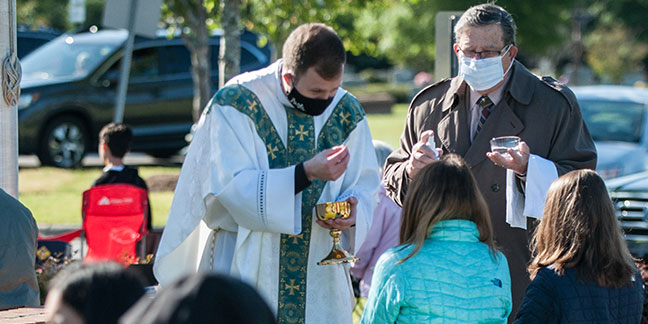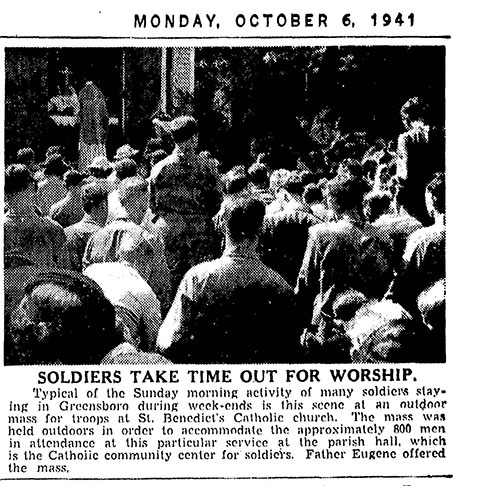 CHARLOTTE — Outdoor Masses and Communion services have given way to indoor Masses with some specific precautions, and more changes are on the way to people’s ability to worship publicly.
CHARLOTTE — Outdoor Masses and Communion services have given way to indoor Masses with some specific precautions, and more changes are on the way to people’s ability to worship publicly.
North Carolina has begun the slow and uneven process of easing public health restrictions that have been in place since mid-March, starting with Gov. Roy Cooper’s announcement May 8 that he was relaxing restrictions on businesses, travel and public gatherings as part of a three-phase reopening process. For churches, “Phase 1” meant being able to hold outdoor worship services in which people could leave their cars.
Then in response to a lawsuit challenging that restriction on churches, a circuit court judge issued a temporary restraining order May 16 to block it – essentially giving churches the green light to hold indoor services with no crowd limits other than generally abiding by social distancing and sanitizing guidelines.
On Friday, May 22, the state moves to “Phase 2,” further relaxing some restrictions and removing the “stay-at-home” order.
Many churches across the diocese arranged outdoor Masses or Communion services once North Carolina entered “Phase 1,” but only in the past few days have some opted for indoor liturgies.
Throughout all the ups and downs, all of them are trying to navigate the rule changes while ensuring social distancing and frequent sanitizing.
Parishes that had been offering “parking lot Masses,” in which people stayed inside their cars during Mass, switched to outdoor Masses in which people could get out of their cars and sit spaced safely apart. Other parishes began offering outdoor Masses, enabling their parishioners to attend Mass in person for the first time since the pandemic hit in March.
Indoor Masses are now being offered at the discretion of each pastor. A few churches began offering daily Masses inside this week and plan to offer Sunday Mass starting this weekend, albeit with some limitations to maintain social distancing.
As the situation remains fluid, people should check their parish’s website and social media for the latest information on church openings, Mass times and sacrament guidelines.
Whether liturgies are held indoors or outdoors, all churches are continuing to follow public health directives to reduce the transmission of COVID-19. For example, clergy are wearing personal protection equipment and sanitizing their hands during the distribution of Holy Communion. Mass-goers are being urged to remain at least six feet apart (excluding members of the same family or household), wear a mask or cloth covering their nose and mouth, and wash or sanitize their hands when they arrive and when they leave.
Throughout the diocese, the Sunday Mass obligation remains suspended, and everyone is asked to exercise prudence in deciding whether to attend Mass in person. People who are ill or vulnerable to infection are still strongly encouraged to stay at home and attend Mass virtually on TV or streamed live online.
In addition to outdoor and indoor Masses, churches have continued offering “drive-up” Eucharistic Adoration and confessions, livestreamed vespers services and recitation of the rosary, and other offerings to provide the faithful with opportunities to pray.
Some parishes have also been hosting talks online from mental health professionals at their parish, to help people stay positive and deal with the stress of isolation.
Parishes with schools have also been honoring their Class of 2020 graduates, extending blessings to them and their families.
On May 22, “Phase 2” of the governor’s reopening plan will begin, further reducing some restrictions as the state emerges from the COVID-19 pandemic. Phase 2 keeps indoor public gatherings at 10 people and outdoor gatherings at 25 people, but churches are specifically excluded from those limits.
Regarding weddings, baptisms and funerals, “Phase 1” meant churches could host weddings and baptisms for up to 10 people inside church, and funeral services of up to 50 people. In “Phase 2,” these liturgies are excluded from the governor’s directives – allowing any number of people to attend – but receptions or visitations before and afterwards are limited by the indoor and outdoor public gathering restrictions. Many of these services are being postponed until public health restrictions are eased further and more people are allowed to attend.
Social distancing, face masking and other public health directives remain in effect.
— Patricia Guilfoyle and SueAnn Howell, Catholic News Herald
Pictured: Father John Eckert, pastor of Sacred Heart Church in Salisbury, distributes Holy Communion at the parish’s outdoor Mass May 17. (Bill Washington | Catholic News Herald)
Mass al fresco
From forests to battlefields, outdoor worship amid crisis has a storied past that includes Greensboro
 GREENSBORO — A holy anticipation grew to a crescendo May 10 as many North Carolina Catholics attended open-air Masses and received Our Lord in the Eucharist for the first time since pandemic restrictions began eight weeks prior.
GREENSBORO — A holy anticipation grew to a crescendo May 10 as many North Carolina Catholics attended open-air Masses and received Our Lord in the Eucharist for the first time since pandemic restrictions began eight weeks prior.
Greensboro’s Our Lady of Grace Church offered three outdoor Masses in English, Spanish and Latin. Individuals and families knelt in the grass six feet apart as they worshiped together for the first time since March 14. Tears started flowing as Franz Schubert’s “Ave Maria” filled the air in the familiar voice of Andrew O’Connor, the parish’s music director.
“People were elated, joyful and showing great piety,” O’Connor said. “I think this is going to bring a renewed vigor of people’s faith because they’ve been without the Eucharist for so long.”
As unusual as the current situation is, emotions ran high at open-air Masses in Greensboro once before. In the fall of 1941, the nation faced a different global crisis – the Second World War. As the
U.S. prepared to enter the conflict, Greensboro hosted thousands of troops on break from the rigors of mock warfare in Eastern North Carolina.
St. Benedict – Our Lady of Grace’s “mother church” – ministered to the Catholic troops offering hospitality and a multitude of outdoor Masses to accommodate crowds. The optics were starkly opposed to those on May 10, however. Several hundred servicemen huddled together to worship, and there appeared to be no limit on congregation size.
Greensboro native Monsignor Joseph Showfety, then 14, recently recalled the events. “They used the stoop for Mass, and the men would kneel on the same level as the hall or in the middle of the street,” he said.
“They (the police) blocked off Elm, Eugene, Greene, and the priest would say Mass outdoors, and people would sit out on front porches to watch the whole thing.”
Monsignor Showfety also noted that the pious soldiers caught the attention of many in the Protestant community, including a nearby Presbyterian minister who was so impressed with the young men’s midnight fast prior to Mass that he talked about it on the radio.
Spiritual warriors Benedictine Father Eugene Egan and Benedictine Father Cornelius Diehl offered the Masses as did Father James P. McLarney of Chicago and “The Catholic Hour” radio program. The church’s four-Mass schedule swelled to nine before it was all over, and an estimated 800 soldiers attended one service. A week later, there were about 2,000 troops at the Sunday Masses.
St. Benedict came of age in its wartime role, making a deep impression on people in Greensboro and across several states. With influence beyond its usual scope, the parish unified thousands and brought Jesus in the Eucharist to scores of servicemen, spiritually fortifying them before they headed into the bloodiest war in history. Today, this fortification is as crucial as ever.
— Annie Ferguson, Correspondent














